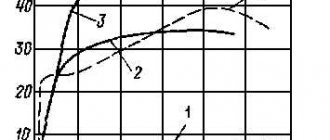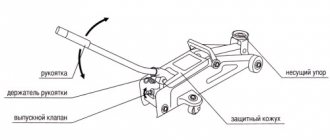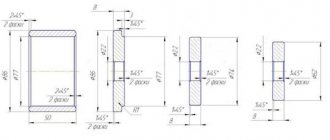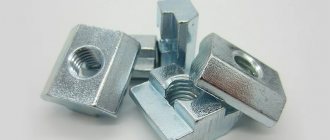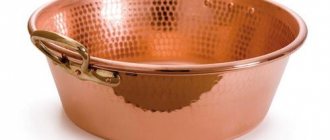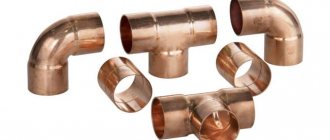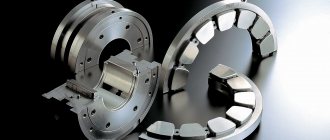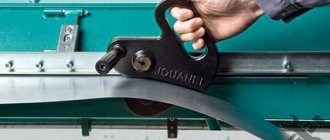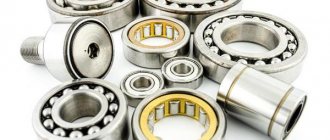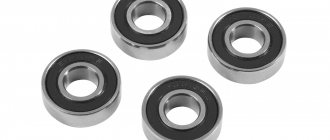In order to remove the bearing from its installation location, use a puller. It has grips with which the bearing is grabbed and pulled together by the force of the spindle.
Always keep in mind that the force must be applied to the bearing race that is installed with interference.
Pullers are either mechanical or hydraulic, depending on the type of spindle used. As a rule, if necessary, the spindle can be replaced with another one.
Range of bearing pullers
Types of pullers by type of grip
There are 4 main types available for different types of gripping and dismantling:
- External puller Designed for external dismantling, when the inner ring of the bearing is installed on the shaft, and the outer ring can be grabbed from the outside.
- Internal puller Designed for internal dismantling, where the outer race of the bearing is installed in the housing and the hole in the inner ring can be grasped from the inside.
- Separator puller Designed for dismantling with gripping the bearing from behind using a tension separator, when its rear part is adjacent to the surface and the external type is not suitable.
- Puller with grip between rings Designed for dismantling bearings that are installed simultaneously on the shaft and in the housing, and all other types are unsuitable.
With swivel grips
They are more varied in design. The grips in them are locked with bolts.
A puller with two rotating double-sided jaws has stops that have different widths at both ends of the jaws. It comes with three rotating one-sided grips; the reach of the grips can be changed by rearranging them. There is also a model that can be used with either two or three rotating single-sided grips. There are 4 points on the body of the puller for installing grips.
Some can be used with an impact (inertial) puller. They can also be used as internal ones, but then the clamp can no longer be used to secure the grips. Crossed grips allow you to change the grip over a wide range. A small (working width up to 50 - 70 mm) tool of simple design, originally intended for removing the ends of battery cables, but is widely used for dismantling various small parts.
External bearing pullers
They work like this - the spindle tip rests on the shaft, and the claws cling to the outer ring.
To select the appropriate size external puller, you first need to determine the width and depth of the grip, and the required width of the grip jaws. Next, you need to evaluate the expected conditions of use in order to select its type.
If different grip depths and widths are required, you need a universal puller with movable parallel grips. The width is set by shifting the grips in the guides, and the depth by the axial position of the spindle. We offer tools with a working width range from 90...120 to 250...650 mm and a maximum working depth from 100 to 500 mm.
If the same operating conditions are expected, a puller with self-centering grips is suitable.
When different grip depths are planned, the best choice is a puller with articulated grips
For external gripping of bearings adjacent to the back of the surface, or if there is a risk of the jaws slipping, you should choose a puller with a side clamp that tightens the jaws together during operation.
Universal
This is the most common type of this instrument. Pullers are used to remove bearings, gears, pulleys, etc. The basis of the design is a power bolt, the rotation of which creates a dismantling force applied to a support point located on the unit being dismantled. Through the central body of the puller, this force is transmitted to the grippers that are in engagement with the part being dismantled. If the protrusions of the grippers are directed inward, then the puller is external. If you turn the grips with the protrusions outward, the tool becomes internal. Some models are combined, i.e. external/internal. Other models are not adapted to such a transformation and can be used only as external or only as internal; the basic principles of their operation do not change from this.
The suitability of a tool for performing any operation is determined by the following parameters:
- The maximum permissible load is determined both by the strength of the power bolt and the central body of the tool, and by the number of grips and the strength of an individual grip. The maximum permissible load may be specified by the manufacturer, but it is almost impossible to numerically estimate the force required to dismantle the part. For this reason, when choosing, they usually take into account only its compliance with the dimensions of the part being dismantled;
- The working stroke is determined by the reach of the power bolt, the length of the grips, as well as the location of the points of application of the dismantling force;
- The geometric dimensions of the grips, primarily the height of the stop and, to a lesser extent, the width of the stop;
- Maximum and minimum gripper opening.
The main difficulty in application is that the grips and stop points of the power bolt tend to move during operation. Many structures have various types of devices designed to counteract such displacement. However, these devices cannot be universal. While effective in one situation, they may be completely useless in another.
Internal bearing pullers
They allow you to grab the bearing by the hole in the inner ring and pull it out of the housing. When choosing, it is necessary to determine the diameter of the bearing bore and select the type of spacers - three-jaw, segment or for needle bearings. We offer pullers for hole diameters from 5 to 200 mm.
Next, if there is a supporting surface on the body for a stop, you need to choose a puller with a counter support and a spindle.
Otherwise, you need a puller with a reverse hammer.
Types of universal pullers
There are two types of universal pullers - mechanical and hydraulic. The former are easier to operate, cheaper and more effective. They create a load on the spare part approximately equal to the strength of a person. This tool consists of a central rod on which there is a universal thread, and 2 or 3 legs. Mechanical tools are used for bearings and similar parts.
Hydraulic devices can withstand loads of up to several tens of tons. They have a hydraulic cylinder and do more serious work than power tools. Often used in cases where the spare part is located deep and it is necessary to avoid damage to third-party parts.
Algorithm for pressing out and replacing the support bearing yourself
Preparatory stage: a set of automotive tools, new spare parts, a mobile jack, a wooden block.
Initially, the rotating mechanism is dismantled and the hub is pressed out. If there is a retaining ring, it must first be removed. Next, the support bearing is pressed out of the steering knuckle itself. After complete dismantling, it is necessary to carry out visual diagnostics, remove the remains of old lubricant, metal shavings, and other waste products.
If there are no defects, then a thin layer of lubricant is applied to the cavity of the seat. For domestic cars, it is enough to use Litol-24M type lubricant; for foreign brands, any graphite-based lubricant.
The new support bearing is pressed into place in a vice. This must be done extremely carefully, since even the slightest misalignment can deform the seat. The assembly process follows in reverse order. At the end of the procedure, it is imperative to balance the wheels, since a new part is installed.
The car is ready for further use. The length of the period directly depends on the quality of spare parts, assembly, and professionalism of the craftsman. The main role is given to the style and manner of controlling the technical equipment.
Exploitation
Before use, read the instructions and assemble the device correctly. Correctly position the rod relative to the bearing or other element to be removed. For this purpose, the puller has special devices. More often, three-legged clamps are used, acting as a stop. After securing the paws, the position of the working rod is adjusted.
Then do the following:
- Check the reliability of the puller's fixation.
- Using the working fluid injection system, pressure is created in the cylinder.
- When the rod moves, check its position relative to the pressed part.
- Monitor the pressure on the bearing, systematically checking its integrity.
- After dismantling, the rod is returned to its original position.
To maintain the device in working condition, the level of the working fluid is checked, and rubber seals and bushings are periodically replaced.
Do not exceed the rated operating pressure in the hydraulic cylinder when using additional mechanisms!
Design features
The hydraulic system of the device acts on the support rod. To fix the puller relative to the part being removed, different support platforms are used:
- clamping claws;
- sites;
- other.
First of all, a hydraulic puller is installed on the structure with a bearing (another element), and then the rod is positioned. The hydraulic system provides pressure on the part being removed, and it is squeezed out of its socket.
Our device allows you to remove the following structural elements:
- bearings;
- pins;
- bushings;
- gear transmissions;
- couplings;
- brake discs;
- crankshafts.
Pullers are used at car service stations and repair shops. They are quite simple in design and can work without electricity , compressed air, etc.
Steering rod puller
Theoretically, when repairing a car, you can get by with fairly simple means. Let's give an example. To press out the tie rod ends, it is enough to have a device known since time immemorial in the form of a wedge-shaped two-pronged “fork”, which is driven like a wedge between the tip of the tie rod and the lever, where its finger enters, passing the latter into the cut of the fork. The success of the operation depends on how accurately the master strikes the end of the device with a heavy hammer, as well as with what force he does this. You need to hit accurately so as not to damage the steering tip boot, nearby components and assemblies, and at the same time not to injure the fingers of your own hand, which holds (guides) the “fork”. To simplify this operation, reduce the time for disassembling the connection, do it as carefully as possible and not cause injury, you need to use a hydraulically driven puller, which, like a miniature jack, opens the parts, loosening the press fit. To work with highly acidified compounds, it is necessary that the device develop a sufficiently large force. As the practice of our clients has shown (most of them are owners of large service stations), in order to disassemble even the most “hopeless” connection, a force of 15 tons, developed by hydraulics, is sufficient.
With conical jaw lock
They have two or three grippers and are intended for use in cases where it is necessary to eliminate the asymmetrical load application during dismantling. They provide automatic centering of the jaws using a conical nut that is hand-tightened when the puller is installed. Sometimes this nut is spring loaded.
For external and internal use of such a puller, grippers of different shapes are usually used. Less commonly used is a specially shaped nut that allows the jaws to be reversed so that the puller can be used as an external or internal puller. They are often included in kits along with impact pullers.
Types of hydraulic pullers
The designs and technical characteristics of devices can be very different. To choose the optimal model, carefully analyze the operating conditions. At a specialized service station, for example, mobility, the ability to install in hard-to-reach places and reliability are important.
The first step is to find out the maximum force that the hydraulic system provides. For work in a car service, models with a pressure of up to 15 tons are sufficient. When it is necessary to dismantle large bearings, more powerful pullers are selected.
Depending on the design, the following selection parameters are distinguished:
- A type of pump that can be built-in or remote. In the first case, the compactness of the model increases. To work with complex structures, it is recommended to choose a hydraulic puller with a remote hydraulic system.
- Type of clamp - paws or platform. The platform is used when it is possible to make mounting holes. The paws are used for installation on the structure without violating the integrity.
- Method of increasing pressure in a hydraulic cylinder. This can be done manually or using external devices - hydraulic pumps or compressors. These devices allow you to quickly create the required pressure in the device.
Increased functionality of some models is achieved through the ability to install clamps. In addition, the mobility of the device is taken into account. Stationary models allow bearings or similar units to be removed after the structure has been installed in the machine. Mobile models are mounted on the hub or other element of the car.
The applied force is monitored by a built-in dynamometer. This helps prevent damage to the element being removed.
pullers
The times when most plumbing operations were carried out, as they say, “on the knee” are long gone. Foreign-made vehicles, as well as structurally relatively simple domestic cars, having received imported components and assemblies, now require a qualified approach to their maintenance and repair using special tools and devices. This is dictated by the requirements for the quality and timing of certain operations specified in the regulations for the maintenance and repair of equipment.
Since mechanics do not use this type of locksmith equipment as often as conventional locksmith tools - wrenches, socket heads, wrenches and extensions, the owner of a service station or the manager of a repair area of a large ATP is tempted to save money and buy cheaper pullers. Fortunately, tool manufacturers from China, India and Turkey have literally flooded the market with analogues, or even exact copies of devices from famous companies. But not all servicemen realize that the price of a puller includes not only materials, but also the technologies with which it is made.
In other words, two tools that are absolutely identical in appearance will have different consumer properties. We’re not even talking about the service life of a cheap tool. It's frankly small. The second extreme is the unreasonably inflated price for products manufactured under the famous brand of a manufacturer of commercial vehicles and/or components and assemblies. Manufacturers of commercial vehicles will never independently develop special tools and equipment. They delegate tasks for the production of these devices to companies that specialize in this. In addition, these firms produce the same devices for the free market.
To produce devices for both markets, these companies do not skimp on the quality of the materials from which they make their products. The technologies are also the same. It turns out that the consumer must pay more for tools and equipment that are identical in quality only because they have a special mark. It’s no wonder that prudent business owners adhere to the “golden mean” rule. Let's consider pullers from companies from this very middle.
